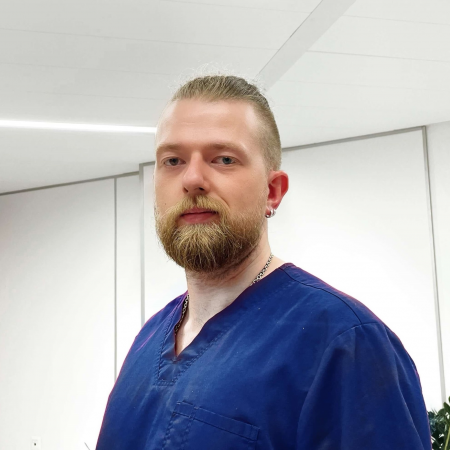Cava filter
Thrombosis is a fairly common disease among the adult population in Ukraine. Against the background of the pathology of the circulatory system or with blood coagulation disorders, thrombus or blood clots begin to form in the peripheral veins (most often the veins of the lower extremities). Under the influence of various factors, blood clots can be destroyed or detached from the walls of blood vessels, and large fragments enter the lumen of the inferior vena cava, from where they migrate to the branches of the pulmonary artery, leading to thromboembolism. If the blood clot is small, the person feels a lack of oxygen, weakness, dizziness. If the blood clot completely blocks the lumen of the vessel, the outcome can be tragic. Today, pulmonary embolism (PE) is the fourth cause of sudden death in the world. To prevent the development of such a complication of thrombosis, cava filters were created - a special metal device designed to "catch" migrating blood clots in the lumen of the vessel.
What is a cava filter?
The kava filter is a mesh construction that resembles a half-open umbrella. They are made of inert metals, most often steel with a special anticoagulant coating, titanium, or nickel-titanium alloy. The cost of implanting a cava filter varies depending on the material used. Modern kava filters meet strict requirements: they do not corrode, reliably trap blood clots, are tightly fixed, are easy to install, and have no ferromagnetic properties.
There are temporary and permanent kava filters. Temporary devices are usually installed for a period of increased risk of thromboembolism rupture (for example, during childbirth, during surgery, or a course of thrombolytics) and removed after elimination of factors that can lead to PE. Permanent kava filters are fixed for life.
Indications for installing a cava filter
Blood clot trap implantation is indicated for the following conditions:
- deep vein thrombosis of the lower extremities with the presence of a floating thrombus;
- deep vein thrombosis with concomitant atrial fibrillation, coronary heart disease, heart failure;
- pulmonary embolism in the patient's history;
- for the prevention of PE in patients receiving high-dose chemotherapy;
- patients at risk before surgery to exclude thrombotic complications in the early postoperative period;
- ineffectiveness or contraindications to the use of oral anticoagulants due to the high likelihood of bleeding in patients with thrombosis.
Contraindications to the installation of a kava filter
There are no absolute contraindications to device implantation.
Relative contraindications are:
- critically narrowed lumen of the vena cava;
- lack of access to the vessel;
- age under 18;
- the presence of acute infectious diseases;
- thrombosis in the adrenal region of the vena cava.
Preparation for implantation of the cava filter
Before installing the device, it is necessary to undergo a specialist consultation and a complete examination of the body, usually including general clinical laboratory and instrumental studies. It is necessary to inform the attending physician about all medications you are taking, whether you have an allergic reaction to anything, as well as about any previous illnesses and operations. Women in no case should be silent about the fact of pregnancy, and patients with diabetes are required to warn the doctor about the disease to adjust the administered dose of insulin. On the eve of the procedure, it is recommended to have dinner with light food, no later than 12 hours before the surgery. Jewelry, eyeglasses, and any metal objects that will be visible in the image and may obstruct the visualization of the inferior vena cava should be removed during the procedure.
Operation progress
The installation of the cava filter is performed in an X-ray operating room using a minimally invasive endovascular method - through a puncture in the skin. Local anesthesia is used, but sedation is possible at the patient's request or indications. A special iodine-contrast substance is injected into the inferior vena cava, due to which the lumen of the vessel is visualized. The phlebologist then punctures and inserts a flexible wire through a catheter in the jugular, femoral, ulnar, or subclavian veins. Under the control of an X-ray machine, the guidewire with a fixed cava filter is advanced to the installation site, after which it is released and fixed. The guide catheter is removed from the vessel, the puncture site is processed and covered with a sterile bandage. After the cava filter is implanted, an X-ray is taken to check its location. The duration of the procedure usually takes about 40-60 minutes. The operation does not require stitches or a rehabilitation period. However, to avoid complications, patients are prescribed a two-day bed rest with limited physical activity, as well as a course of antibiotics and anticoagulants.
Experts recommend that patients monitor their feelings in the postoperative period and contact their doctor if the following symptoms appear:
- swelling of the legs;
- painful sensations in the chest;
- temperature increase;
- shortness of breath.
It is worth emphasizing that although the implantation of a cava filter is an effective method for preventing pulmonary embolism, it does not in any way affect the root cause of the thrombus formation process, which means it will not be able to warn the patient against the appearance of blood clots in the future.
Specialists of Dobrobut clinics will help you to carry out the procedure of implantation of a cava filter in Kyiv. We use the latest medical and diagnostic equipment, provide services at the European level, and at the same time have loyal prices. Do not postpone your visit to the doctor until tomorrow, make an appointment today by calling our call center or choosing a convenient time for your visit through the website.
Bibliography
- Inferior vena cava filters: a framework for evidence-based use
- John A. Kaufman - Society of Interventional Radiology Clinical Practice Guideline for Inferior Vena Cava Filters in the Treatment of Patients with Venous Thromboembolic Disease. Published online, 08 September, 2020.
- Elliot DeYoung, Jeet Minocha - Inferior Vena Cava Filters: Guidelines, Best Practice. Published online, June, 2016





